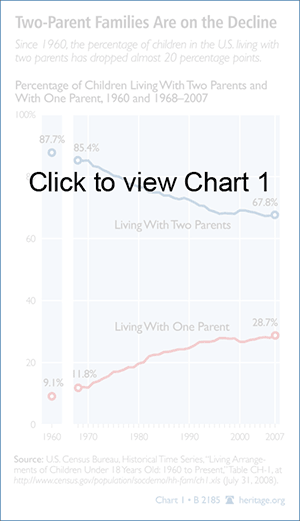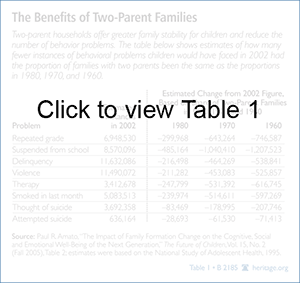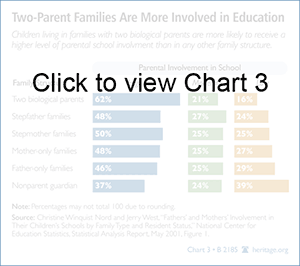Despite this increase in public spending, student achievement and educational attainment over the last four decades has remained relatively flat. In 2007, a significant portion of students, disproportionately from disadvantaged backgrounds, scored "below basic" in reading and math on the National Assessment of Educational Progress (NAEP). Sadly, in many of the nation's largest cities, fewer than half of high school students graduate.[3]
While academic research has consistently shown that increased spending does not correlate with educational gains,[4] the research does show a strong relationship between parental influences and children's educational outcomes, from school readiness to college completion. Two compelling parental factors emerge:
- Family structure, i.e., the number of parents living in the student's home and their relationships to the child, and
- Parents' involvement in their children's schoolwork.
Consequently, the solution to improving educational outcomes begins at home, by strengthening marriage and promoting stable family formation and parental involvement.
The Erosion of Family Stability in America
"Perhaps the most profound change in the American family over the past four decades," writes sociologist Paul Amato, "has been the decline in the share of children growing up in households with biological parents."[5] In 1960, 88 percent of all children lived with two parents, compared to 68 percent in 2007.[6] (See Chart 1.) In 1960, 5 percent of all children were born to unmarried mothers. That figure rose to 38.5 percent in 2006.[7] (See Chart 2.) Demographers have estimated that, overall, one child in two will spend some portion of his or her childhood in a single-parent family.[8]
Studies show that children raised in intact families, i.e., with two continuously married parents, tend to fare better on a number of cognitive, emotional, and behavioral outcomes than children living in other family forms.[9] Not surprisingly, the changes in family structure over the last 40 years have affected child and adolescent well-being. In 2002, nearly 7 million children between the ages of 12 and 18 repeated a grade. Based on this figure, Professor Amato estimates that if the share of two-parent families had remained unchanged between 1980 and 2002, some 300,000 fewer teens would have repeated a grade. Some 750,000 fewer students in 2002 would have repeated a grade if the share of two-parent families remained at the level it was in 1960.[10] (See Table 1.)
Social science research over the past decades suggests that family structure affects children's school outcomes, from preschool to college.[11] Some of the variations in school performance could be explained, in part or in whole, by the differences in family resources such as time and money, family dynamics and parental characteristics that are associated with the various family forms. These are mediating factors, or mechanisms through which family structure affects schooling outcomes. Family structure may also exert a direct influence, independent of mediating factors. Thus, depending on the outcome, family structure's total effect may consist of one or more mediating influences or a combination of both direct and mediating influences.[12]
Though various methodological research issues— e.g., data quality, inconsistent definitions of family structure, the selection effect (e.g., are individuals who possess better parenting qualities more likely to choose marriage and stay married, or does marriage per se bolster children's well-being?)—limit the findings, the evidence, nonetheless, is strong: Family structure matters.[13]
School Readiness. A number of early-childhood outcomes contribute to children's eventual school readiness. The evidence suggests that potentially important early-childhood outcomes vary by family structure. One study, analyzing 1,370 mothers in the Fragile Families and Child Wellbeing Study who were continuously married or in cohabiting relationships from the child's birth to age three, found that three-year-olds born to cohabiting mothers tended to exhibit more aggressive, withdrawn, and anxious or depressive behavior than children born to married mothers.[14] For aggressive and withdrawn behaviors, the association was explained by income differences. For anxiety and depressive symptoms, even controlling for income, the cohabitation effect remained.
Studies show that reading to young children aids their literacy development. Toddlers and preschool-age children in married-parent families are read to more often than peers in non-intact families.[15] One study of 11,500 kindergartners living with two parents orparent figuresreported that, accounting for parental education and income, children living with married parents averaged higher reading achievement test scores than peers living in cohabiting or stepparent families.[16]
Elementary and Secondary Education. The research on family structure and elementary and secondary educational outcome is extensive.[17] Studies have reported that:
- First-graders whose mothers were married when they were born are less likely to engage in disruptive behavior with peers and teachers than those whose mothers were single or cohabiting at the time of their birth.[18]
- Children aged three to 12 who live in intact families have higher average math scores than peers whose mothers live in cohabiting relationships.[19]
- The association between family structure and nine-year-olds' science and math achievement appears to be cross-national.[20]
- Children aged seven to 10 who live in continuously intact families tend to score higher on reading tests than peers who have lived in other family structures.[21]
- Children aged six to 11 who live in intact families tend to be more engaged in their schoolwork than peers in other family structures.[22]
- Eighth-graders in two-parent families perform, on average, better on math and science tests than peers in single-parent or stepparent families.[23]
- The predominant family structure of a school's student population appears to be linked to the individual science and math scores of eighth-graders.[24]
- Ninth-graders whose mothers were married when they were born are more likely to complete an algebra course than are peers whose mothers were single when they were born.[25]
- Middle school and high school students who experience a parental divorce tend to suffer declines in their grade point averages and are more likely to fail a course one year later compared to peers of married parents; the evidence suggests a causal link.[26]
- Among middle school and high school students, the portion of childhood spent in a single-parent family is associated with declines in GPAs over time; and living in a single-mother family with a cohabiting partner is associated with a greater likelihood of suspension or expulsion from school at a later time.[27]
Finally, studies have also shown a robust link between family structure and high school dropout or graduation rates, and the evidence suggests that the relationship may be causal.[28]
Higher Education and Educational Attainment. The impact of family structure on educational outcomes appears to last into young adulthood. Throughout the college entrance process, students from non-intact families tend to fall behind their peers from intact families. The gap increases when the process involves selective college admission.[29] Overall, children from intact families complete more years of schooling and achieve higher educational attainment than do peers from other family forms.[30]
One study, analyzing two nationally representative data sources, reported that longer durations in single-parent or blended families during childhood appear to have a negative impact on college attendance and graduation. Though family income and parental education explained the association between single-parent families and lower college attendance and graduation rates, the disparities in these outcomes between children in intact families and those in blended families persisted.[31]
Similarly, another study showed that, accounting for family income and estimated financial aid, an average student from a non-intact family was 5 percent less likely to attend a four-year college and 6 percent less likely to graduate from college than an average student from an intact family.[32]
Parental Involvement
Parental involvement emerges as another robust influence on educational outcomes. It is multi-dimensional. Examples include monitoring children's activities outside home and school; setting rules; having conversations about and helping children with school work and school-related issues; holding high educational expectations; discussing future planning with children and helping them with important decision making; participating in school-related activities such as meeting with teachers and volunteering in the classroom; and reading to children or engaging in other enrichment or leisure activities together.
A meta-analysis of 77 studies, consisting of 300,000 elementary and secondary students, found that parental educational expectations are a particularly important aspect of parental involvement. [33] Parenting style, reading to children, and, to a lesser extent, participation in school-related activities appeared to be influential as well. Furthermore, parental involvement is associated with multiple measures of student achievement, for the entire student population as well as for minority and low-income student populations. Overall, "the academic advantage for those parents who were highly involved in their education averaged about 0.5–0.6 of a standard deviation for overall educational outcomes, grades and academic achievement."[34]
Parental Involvement and Family Structure. The level of parental involvement varies by family structure, and the relationship between parental involvement and educational outcomes depends on the family context as well.[35] One study, for example, found that compared to high school students from intact families, those from single- or stepparent families reported less parental involvement in their school work, supervision, and parental educational expectations, which, in turn, affected school outcomes.[36]
Early Childhood.[37] Studies show that a sensitive, warm, and responsive type of parenting and engaging in play activities with young children bolster their social and emotional development, communication skills, and ability to focus.[38] Doing arts and crafts with children, reading to them, showing them how to write words, and using a more complicated vocabulary around them also aid their literacy and language development.[39] One study reported a link between these types of parental engagement and a range of school readiness outcomes such as "children's motivation to learn, attention, task persistence, and receptive vocabulary and…fewer conduct problems."[40]
Frequent contact between parents and their children's preschools as well as parent participation in school-related activities, such as volunteering in the classroom or meeting with a teacher, appear to benefit children on a number of dimensions, including classroom performance and social interaction with peers and adults.[41] One study reported that children whose teachers perceived more parental involvement tended to exhibit fewer problems and higher language and math competencies compared to children whose teachers perceived less parental engagement.[42] The evidence also suggests that parental school involvement's positive influences buffer against some of the negative effects of poverty.[43]
Elementary Education.[44] Parental involvement during elementary school affects children's schooling outcomes as well. The quality of the parent-child relationship is significant. Middle school students who received sensitive, supportive parenting from their mothers during kindergarten tend to perform better in school.[45] Children of parents who frequently praise and show affection to them are less likely to require classroom attention for behavior and socio-emotional issues.[46]
Studies also show that parental involvement in school-related activities during elementary school is associated with long-term educational gains. One study reported that among low-income African-American families, children of highly involved parents during elementary school were more likely to graduate from high school. In the same study, children of parents who were involved in school-related activities for three or more years completed more years of schooling compared to peers of less involved parents.[47] Involvement, specifically by fathers, is significant as well. Children of fathers who visit their classrooms and meet with teachers tend to fare better in school than peers whose mothers are the only involved parent.[48]
Reading with children and the way in which parents read to their children affect children's reading ability.[49] The research shows a distinction between reading storybooks to children, which contributes to their literacy development, and teaching children to read and write, which aids their language development. Both types of activities affect third- and fourth-grade performance.[50] Furthermore, parents' use of vocabulary and their attitude toward homework appear to influence corresponding outcomes in their children.[51] Not surprisingly, children of parents who provide appropriate help with their homework tend to fare better in school.[52]
The home environment in which children are raised plays a role in schooling outcomes. For example, in a study of middle-class families, elementary students whose parents offered them math and science learning materials showed greater inclination toward and interest in math and science activities.[53] Finally, parental expectations of achievement, particularly adolescents' perceptions of such expectations, appear to strengthen their actual motivation and ability in school.[54]
Secondary Education.[55] Parent-child relationship quality continues to be an effective factor in schooling outcomes throughout adolescence.[56] For example, in one study, youths who felt bonded to their parents and enjoyed good communication with them tended to have higher grades and physical well-being.[57] In another study, among low-income youths, those whose parents encouraged individual decision making in their children during early adolescence were more likely to graduate from high school and attend college.[58] Beyond academics, teens who receive more support from their parents are more likely to participate in structured after-school activities, which, in turn, are positively correlated with achievement and social competence.[59]
During adolescence, parental monitoring to the extent to which parents know their children's activities outside of home and school, plays a crucial role in adolescent outcomes, particularly when children and adolescents perceive genuine care from their parents.[60] Parental monitoring is associated with fewer school problems, less substance use, and reduced delinquency. Moreover, parental monitoring is positively linked to social development, school grades, and school engagement, such as paying attention in class and being motivated to do well in school.[61] The evidence also suggests that parental monitoring may have different effects on boys and girls.[62]
Not only does parental involvement in their children's school-related activities send a positive message to students and teachers, such involvement is also related to high school completion.[63] The research also suggests that minority students benefit from their parents' participation in formal leadership roles at the school district level.[64] The effects of parental involvement, however, may vary by parents' education. One study showed that involvement from more-educated parents was associated with fewer behavioral problems in students, which, in turn, affected achievement and aspirations. Among students whose parents are less educated, parental involvement was related to student aspirations but not achievement.[65]
At the secondary education level, high parental expectations continue to yield significant schooling benefits.[66] In one study of high school seniors, "parental expectations for achievement stand out as the most significant influences on [their] achievement growth, high school credits completed, and enrollment in extracurricular academic high school programs."[67] High parental educational expectations are also associated with math and reading scores, interest in school, academic self-discipline, future planning, and motivation for school work.[68] In one study of African-American families, when parents taught that success originates from effort rather than surpassing peers, their expectations had a strong effect on eighth- and ninth-grade math grades.[69] Overall, parental expectations appear more influential than peer effects.[70]
Finally, discussions with parents about the future and pursuing further education support teens' aspirations and college preparation.[71] One study of high-achievement Latino college students found that their parents imparted strong encouragement and values that emphasized education as a means to escape poverty.[72]
Policy Implications
Social science research over the last few decades indicates a strong relationship between family structure, parental involvement and children's educational outcomes, with enduring influences from early childhood to young adulthood. The empirical evidence points to several policy implications:
- Family policy intersects critically with education policy. Fortifying the intact family structure may lead to improvements in individual student outcomes as well as the American education system as a whole.
- Policies that strengthen healthy marriage and stable family formation may bolster child well-being, including school outcomes, both at the individual and aggregate levels.
- Conversely, policies and laws that facilitate further family breakdown may have adverse impacts on children's educational outcomes and provide additional stress on the education system.
- In education reform efforts, greater emphasis on parental involvement and parental choice could yield significant gains in student achievement and attainment. Importantly, the research shows consistent benefits of high parental involvement for minority and low-income students, which deserves serious consideration in light of the achievement gap.
- On the other hand, education initiatives that disregard the importance of families and parental involvement, instead focusing on strategies such as increased expenditures, are likely to continue to prove less effective or ineffective altogether.
Conclusion
American taxpayers invest heavily in education, with annual public education spending totaling $553 billion. The average annual expenditure per child enrolled in a public school amounts to $9,266. Though per-pupil expenditures have increased dramatically over the past few decades, student achievement has remained relatively flat. A significant portion of students attending public schools score "below basic" in reading and math on the National Assessment of Educational Progress. In some of the most disadvantaged central cities in America, fewer than half of high school students graduate.
While numerous education reforms over the last quarter century have demonstrated little impact on overall student achievement,[73] the research clearly shows that the intact family structure and strong parental involvement are significantly correlated with educational outcomes, from school readiness to college completion. Instead of favoring proven ineffective education policies, policymakers seeking effective education reform should consider policies that strengthen family structure in America and bolster parental involvement and choice in education.
Christine C. Kim is Policy Analyst in the Domestic Policy Studies Department at The Heritage Foundation.






